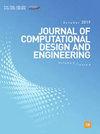基于时-空-时域变换的非线性分布参数系统建模方法
IF 6.1
2区 工程技术
Q1 COMPUTER SCIENCE, INTERDISCIPLINARY APPLICATIONS
引用次数: 0
摘要
复杂非线性分布参数系统(dps)在先进工业热过程中广泛存在。这种高度非线性系统的建模对传统的基于时/空分离的方法是一个挑战,因为它们采用线性方法进行模型简化和时空重建,这可能导致空间基函数所代表的非线性空间结构特征的应用效率低下。为了克服这一问题,本文提出了一种由非线性时域变换和非线性时空重构组成的新型时空建模框架。首先,利用基于局部线性嵌入技术的局部非线性降维,对非线性dps的时空输出进行非线性时域变换;在此步骤中,可以将原始时空数据直接转换为低阶时间系数。然后,利用极限学习机(ELM)方法建立时间模型。最后,通过基于核的ELM方法进行时空域重构,将时间模型得到的时间动态预测重构回时空输出。在快速固化炉和锂离子电池的热过程实验中验证了该方法的有效性和性能。本文章由计算机程序翻译,如有差异,请以英文原文为准。
A temporal-spatiotemporal domain transformation-based modeling method for nonlinear distributed parameter systems
Complex nonlinear distributed parameter systems (DPSs) exist widely in advanced industrial thermal processes. The modeling of such highly nonlinear systems is a challenge for traditional time/space-separation-based methods since they employ linear methods for the model reduction and spatiotemporal reconstruction, which may lead to an inefficient application of the nonlinear spatial structure features represented by the spatial basis functions. To overcome this problem, a novel spatiotemporal modeling framework composed of nonlinear temporal domain transformation and nonlinear spatiotemporal domain reconstruction is proposed in this paper. Firstly, local nonlinear dimension reduction based on the locally linear embedding technique is utilized to perform nonlinear temporal domain transformation of the spatiotemporal output of nonlinear DPSs. In this step, the original spatiotemporal data can be directly transformed into low-order time coefficients. Then, the extreme learning machine (ELM) method is utilized to establish a temporal model. Finally, through the spatiotemporal domain reconstruction based on the kernel-based ELM method, the prediction of the temporal dynamics obtained from the temporal model can be reconstructed back to the spatiotemporal output. The effectiveness and performance of the proposed method are demonstrated in experiments on the thermal processes of a snap curing oven and a lithium-ion battery.
求助全文
通过发布文献求助,成功后即可免费获取论文全文。
去求助
来源期刊

Journal of Computational Design and Engineering
Computer Science-Human-Computer Interaction
CiteScore
7.70
自引率
20.40%
发文量
125
期刊介绍:
Journal of Computational Design and Engineering is an international journal that aims to provide academia and industry with a venue for rapid publication of research papers reporting innovative computational methods and applications to achieve a major breakthrough, practical improvements, and bold new research directions within a wide range of design and engineering:
• Theory and its progress in computational advancement for design and engineering
• Development of computational framework to support large scale design and engineering
• Interaction issues among human, designed artifacts, and systems
• Knowledge-intensive technologies for intelligent and sustainable systems
• Emerging technology and convergence of technology fields presented with convincing design examples
• Educational issues for academia, practitioners, and future generation
• Proposal on new research directions as well as survey and retrospectives on mature field.
 求助内容:
求助内容: 应助结果提醒方式:
应助结果提醒方式:


